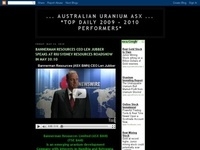Published on Saturday October 22 2011 (AEST)
Since the price peak in 2007, it’s been a hard few years for uranium investors.
Check out this uranium price chart:

Source: Cameco
The price peak is called the ‘Uranium Bubble of 2007′.
The bubble started as investors worried about a uranium shortage.
Back then the uranium supply was a problem… 180 million pounds (81,000 tonnes) were required for nuclear power. But only 108 million pounds were mined.
It was only because of the Russian ‘Megatons to Megawatts program’, where old Soviet nuclear warheads were converted into nuclear fuel, that there was enough uranium to meet the demand from nuclear reactors.
But the tight supply wasn’t enough to cause the 2007 price bubble. That was caused by something else.
Andrew Mickey, an investment analyst at Q1 Publishing, blames it on a disaster at uranium miner, Cameco’s [NYSE: CC] Cigar Lake mine…
Cigar Lake is the world’s largest undeveloped high-grade uranium deposit. But in the lead up to 2006, Cameco claimed Cigar Lake would supply 17% of the world’s uranium needs.
So it’s no surprise that what happened next caused the uranium price to take off…
As Mickey wrote in 2008:
‘The uranium bubble was set to deflate slowly. [But] the exact opposite happened. A retaining wall collapsed and the entire mine flooded. Cameco confirmed a single pound of uranium wouldn’t come out of Cigar Lake for at least five years. [So] the bubble grew even larger.’
With no supply from Cigar Lake, the uranium price reached ‘panic’ levels…
…Until the early days of the sub-prime crisis in 2007. That’s when the uranium price began to crash. So that today uranium is less than half the level it was in 2007.
But despite – or perhaps because of – the lower price, there are still supply and demand problems.
In fact, in its most recent commodity report the Australian Bureau of Agriculture and Resource Economics (ABARE) expects worldwide uranium consumption to rise 6% to 86,800 tonnes this year.
And with 72 nuclear reactors set to open by 2016, ABARE estimates more than 107,300 tonnes will be needed for fuel.
So, where will the supply come from?
There are two sources of uranium for the market. The main source is uranium mined from the ground.
The other source includes nuclear weapons. Amazingly, this market meets up to 30% of uranium demand!
However, the agreement with Russia for the ‘Megatons to Megawatts’ program is due to expire in 2013.
So if the program stops, the supply and demand gap for uranium will get worse.
Simply put, there’s not enough uranium to go around. And that could push the uranium price higher.
Dr. Alex Cowie, editor of Diggers & Drillers says, ‘…if uranium continues to creep up, then we may see the uranium sector finally turn a corner and start the next leg up.
‘We have seen the start of come corporate activity, which is another good sign for the sector. For instance, Korea Electric Power Corporation (Kepco) is the biggest power utility in South Korea, and operates dozens of nuclear plants.
‘A few months ago at the Fremantle Uranium Conference, Kepco announced it was looking for acquisitions so it’s good to see this happening. It has just done a deal with Strathmore Minerals [TSE: STM] to fund exploration of one of its uranium assets.’
As you can see, Alex is bullish on the uranium sector. He goes on:
‘Another deal involves global uranium leader, Cameco. It’s bidding for Canada-based Hathor Exploration [TSE: HAT].
‘These merger and acquisition deals should be a clear sign that the sector is alive and well.’
On Thursday Rio Tinto made a cash offer for Hathor of C$578m, 11% above Cameco’s unsolicited offer.
Large energy firms are trying to cash in on uranium deposits while the price is low. Simply because they understand their future energy needs and want to secure a uranium supply now.
This is good news for some Aussie stocks. Right now, Australia is the third largest miner of uranium… and it’s set to expand further.
Growth for the sector is tipped to be 15% per year until 2015. In fact, by then, Australia could produce 17,000 tonnes of uranium… which would be worth almost $3 billion to the Aussie economy.
This growth potential is why Alex is confident uranium is the perfect stock for risk-hungry investors. He says:
‘The charts for most uranium stocks may be ugly, but the fundamentals of the uranium market are strong.
‘There’s a huge opportunity for investors here with enough patience to stick around.’
 Australian Uranium News - Research
Australian Uranium News - Research


I would like to comment about uranium stocks. I still believe that the energy produced by nuclear power plants' is the most cost effective way to produce electrity compared with coal solar oil or natural gas.
ReplyDelete